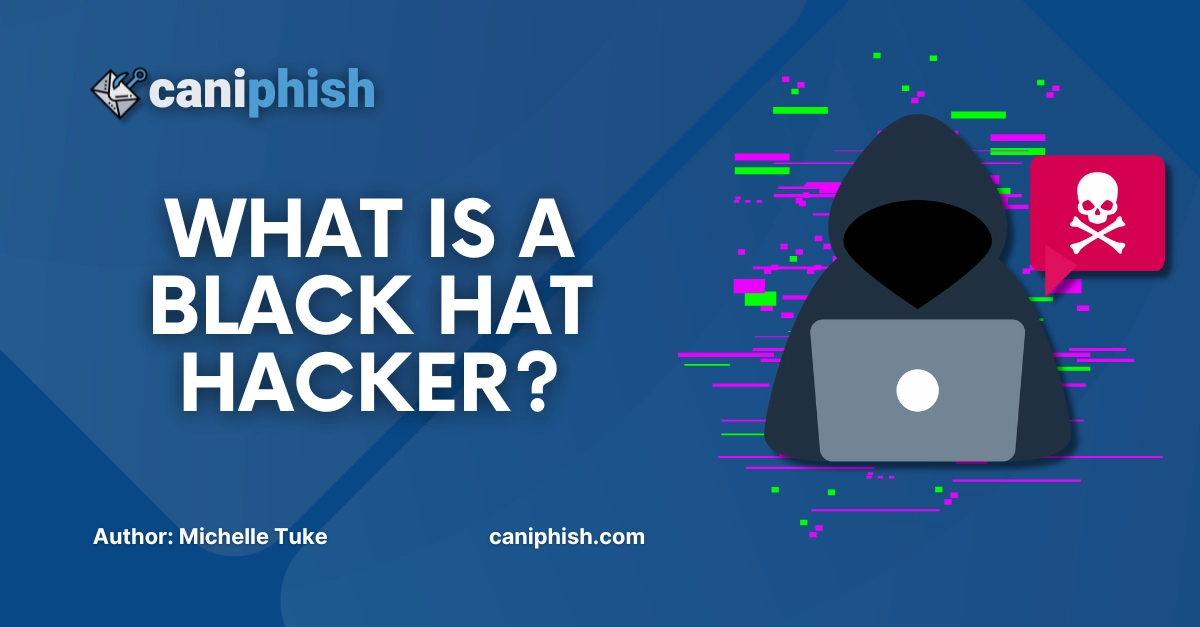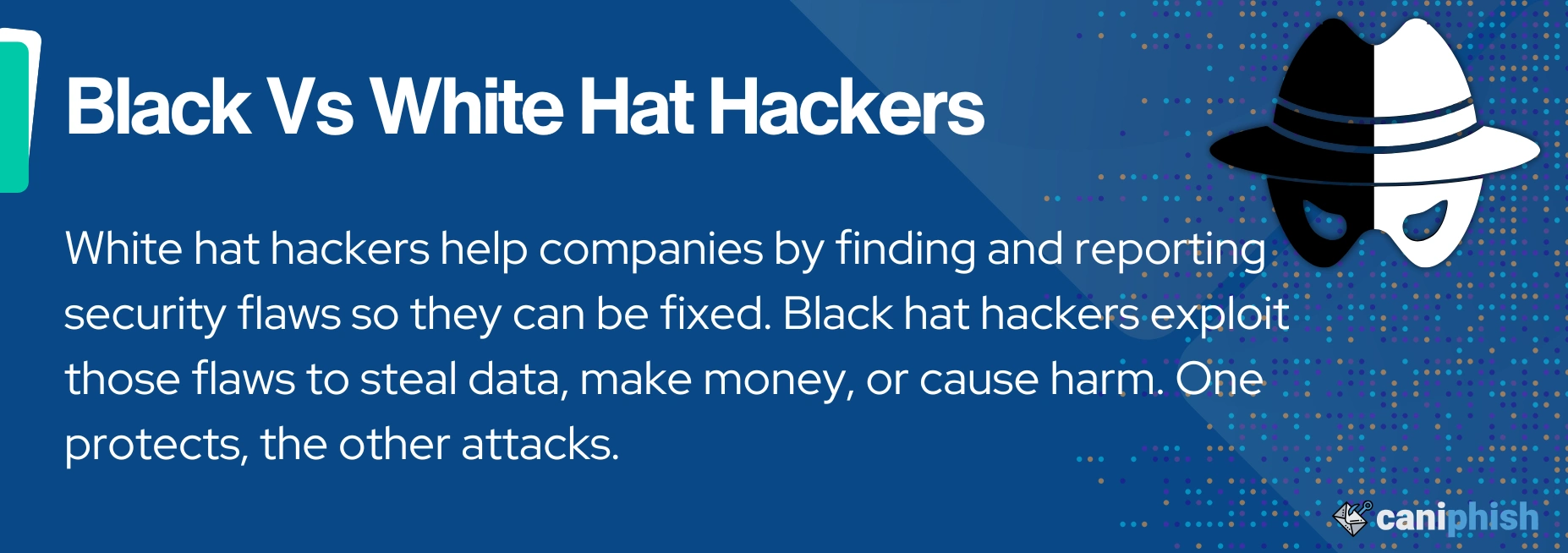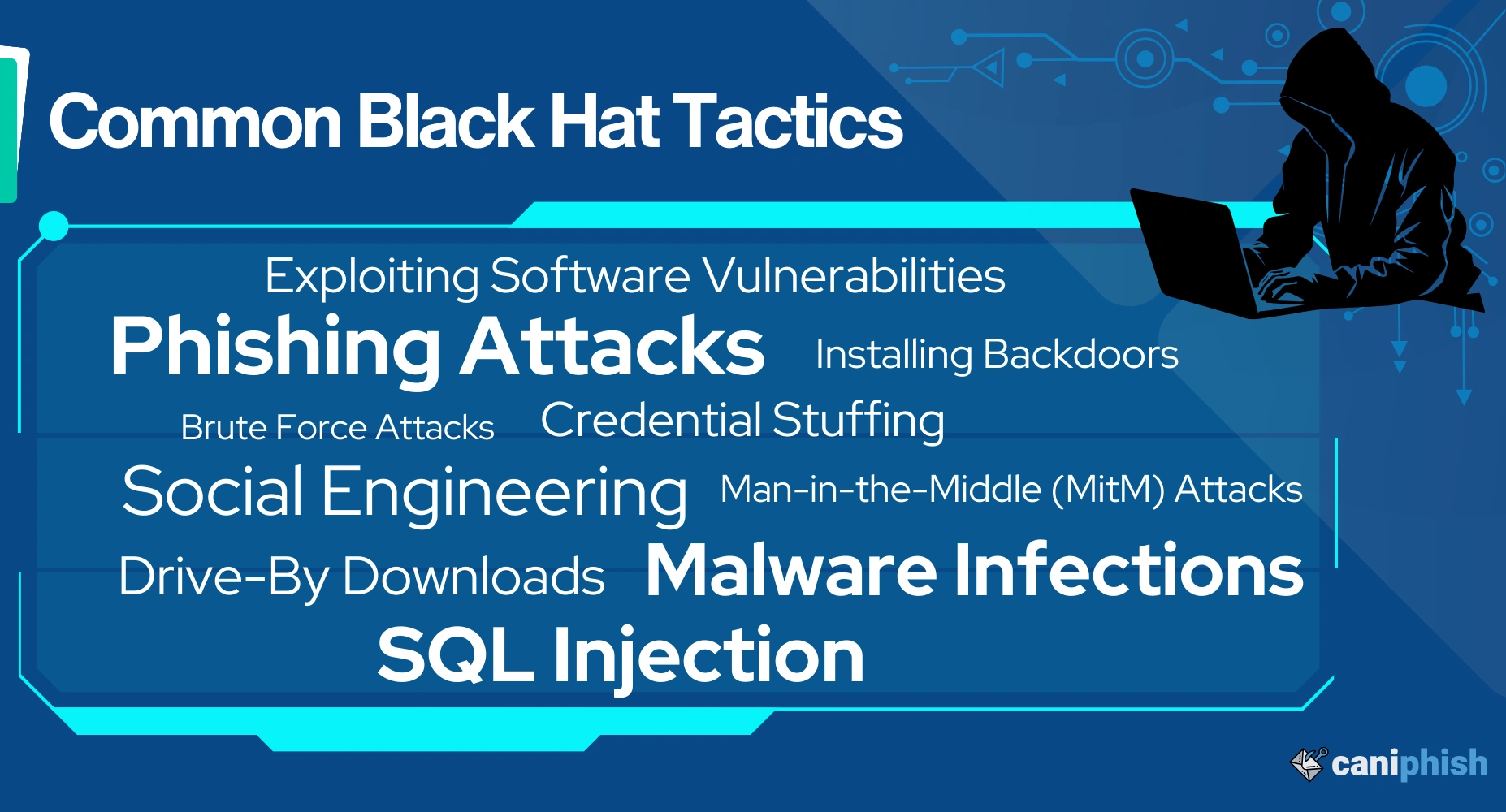What Is A Black Hat Hacker?

A black hat hacker is a cybersecurity term for someone who breaks into computer networks with malicious intent. They violate the law or ethical standards for criminal purposes, such as cybercrime, cyberwarfare, or malice.
What Makes Black Hat Hackers So Dangerous?
Black hat hackers are dangerous because they intentionally break into systems to cause harm. Their goal isn’t to help or warn, it’s to exploit. Here's what makes them a serious threat:
Data Theft
They will try to steal anything that has value, like credit cards, passwords, personal information, and corporate secrets. Then try and sell it or commit further fraud with it.
System Disruption
This is when they intentionally crash systems, take down websites, corrupt files or completely wipe databases just to make a statement, show off or watch the chaos.
Malware Deployment
Black hat hackers deploy malware code such as ransomware, remote access trojans (RATs), and keyloggers to break into systems and spy on users. They steal information and lock systems until a ransom is paid.
Reputational Damage
Businesses can be hit hard with brand damage even if breaches are fixed quickly. Customers lose trust, partners distance themselves, competitors take advantage, and the media run riot with the story.
Financial Loss
Individuals can have their bank accounts drained, and businesses can lose millions. Black hat hackers cause serious damage through ransom demands, direct theft, fraud, and expensive recovery efforts.
National Security Risks
Some black hat hackers are state-sponsored, which poses a serious national security threat. They do things like steal military secrets, spread disinformation, target critical infrastructure, and interfere in elections.
Black Hat Vs White Hat Hackers
White hat hackers are the good guys. They’re ethical hackers who test systems with permission, follow the law, and help fix vulnerabilities before real attackers can exploit them. Their goal is to strengthen security and keep organizations safe.
Black hat hackers do the opposite. They break into systems illegally and exploit weaknesses for personal, financial, or political gain.

Example Of Black Hat Vs White Hat Hacking
Imagine a company is running outdated software with a known vulnerability and a hacker stumbles across it. Depending on whether the hacker is a white or black hat, they would do the following:
White Hat Hacker
A white hat, hired to perform a security audit, finds and reports it. the company patches it before any harm is done.
Black Hat Hacker
A black hat finds the same flaw, breaks in, steals customer data, plants a backdoor, and later sells the data or demands ransom.
What Are Some Common Tactics Used By Black Hat Hackers?
Black hat hackers use common tactics to hack into systems and stay hidden to cause as much damage as possible. Here are some of the method they use:
- Phishing Attacks - Tricking users into clicking malicious links usually through email or by getting login details by impersonating organizations.
- Credential Stuffing - They use stolen and leaked passwords and user names to log into accounts, as people tend to reuse the same password.
- Social Engineering - This is done by impersonating trusted sources like HR, IT support, executives, or even family members to get sensitive information.
- Malware Infections - Black hat hackers deploy trojans, keyloggers, and ransomware to gain control, steal data, or encrypt systems for extortion.
- Exploiting Software Vulnerabilities - A common tactic is looking for vulnerabilities in outdated software, unpatched systems, or misconfigured applications.
- Brute Force Attacks - Hackers use automated tools to guess passwords and crack login credentials, targeting everything from email and web logins to remote servers and encrypted files.
- Drive-By Downloads - Hackers use the technique of infecting legitimate websites or lure users to fakes websites using malicious ads, phishing emails or redirecting.
- Man-in-the-Middle (MitM) Attacks - Hackers use this tactic to position themselves between the victim and another communicating party, such as position themselves between the victim and another communicating party, such as a website or an unsecure public WiFi.
- SQL Injection - By using web vulnerabilities, the attacker inserts malicious code into input fields to manipulate databases.
- Installing Backdoors - Backdoor entry points allow hackers to gain access at a later date. They can take the form of custom malware or modified system files to stay hidden.

How Do I Protect Myself From Being Hacked?
When it comes to protecting yourself in cybersecurity, a few smart steps can go a long way. By locking down your devices and staying alert, you can outsmart hackers before they even get close. Let's dive into them;
- Strong Passwords - Use a password manager to generate and store complex ones and avoid reusing passwords across sites.
- Multi-Factor Authentication (MFA) - Enabling MFA adds that extra layer of security. Always turn it on where available, especially for email, banking, and cloud storage.
- Don’t Click Suspicious Links - Malicious content can be hidden in links and attachments. Verify the sender, check the URL, and don’t act on impulse.
- Keep Software and Devices Updated - To stay protected, by keeping your devices and software up-to-date, enabling automatic updates for your operating system, web browsers, and all your apps.
- Be Cautious on Public Wi-Fi - Never access sensitive data on public Wi-Fi without using a VPN, even if the network has a password. Just because it’s “secure” doesn’t mean it’s safe.
- Limit What You Share Online - Be wary of what you share and post online. Whether it be a photo, post or video. The more you share, the easier it is to target you with social engineering.
- Back Up Your Data - Use cloud backups or external drives. If ransomware hits or your device is compromised, you won’t lose everything.
- Stay Cyber Aware - Hackers evolve, so should you. Take short training courses, follow cyber news, and stay alert. Awareness is half the battle.
Real World Black Hat Hackers
Albert Gonzalez is one of the most well-known black hat hackers. He is responsible for one of the largest credit card thefts in history. From 2005-2007, him and his team hacked into major retailers including TJX Companies, Heartland Payment Systems, and 7-Eleven. They managed to steal more than 170 million credit and debit card numbers using techniques like SQL injection attacks. All the stolen information was then sold on dark web forums and underground markets. This led to major financial losses, identity theft, class-action lawsuits, and a significant breakdown in consumer trust. He was caught and sentenced to 20 years in prison.
This is a perfect example of a black hat hacker. He gained unauthorized access, acted with malicious intent, and exploited system vulnerabilities purely for personal gain.
Step Into The Mind Of A Hacker
The Social Engineer is a high-stakes, turn-based cyber game where you play as an up-and-coming criminal mastermind.
Play now!Frequently Asked Questions
Why Are They Called “Black Hat” Hackers?
The saying "black hat hacker" comes from the old western movies where the heroes wore white hats and the villains wore black hats. Cybersecurity used the same imagery on a digital frontier to explain the difference between hackers. Black hat hackers, operate outside the law just like the movies, exploiting systems for personal gain, and to cause damage.
What Motivates Black Hat Hackers?
While motivations vary from person to person, some do it for financial gain, others just for the thrill and attention. For some, it's more personal and they're doing it for revenge or to support a cause. Whatever the motivation is, someone else always seems to pay the price when it comes to black hat hackers.
Do Black Hat Hackers Work Alone Or In Groups?
Black hat hackers operate both solo or part of a group. It all depends on the intent, the scale, and complexity.
- Solo Operators: These individuals target small-scale targets like personal accounts, insecure websites, or local businesses. They tend to use tools like phishing kits and dark web malware. They're driven by personal profit, revenge, or simply the challenge. An example of a solo back hat hacker is someone phishing for bank credentials using a spoofed login page.
- Organized Groups: These groups have much higher targets in mind, often doing major data breaches, ransomware attacks, or geopolitical sabotage. At this level, black hat hackers often operate as part of well-organized groups. Just like a successful business, everyone has a role, such as coders, initial access brokers, infrastructure managers, and money launderers. An example of an organized black hat hacking group would be LockBit, which operates like a criminal business, complete with negotiation teams and affiliate programs.
Are All Black Hat Hackers Highly Skilled?
You don't have to be skilled to be a black hat hacker. There's ready made kits available on the dark web that are referred to as “exploit kits” or “phishing kits.” This makes it easy for beginers to lauch attacks. There's the moderate skilled hackers that use known exploits, and there's advanced hackers that develop custom malware and lead complex operations. In saying that, black hat hackers require a unique mindset that blends curiosity with malicious intent and a willingness to break the rules. What really sets black hat hackers apart is intent, and the complete disregard for laws, ethics, or consequences.
Can A Hacker Switch From Black Hat To White Hat?
Absolutely! Some black hat hackers are caught, and given a second chance, while others do it by choice. During 1980 and the mid-1990s, Kevin Mitnick was the most wanted hacker by the FBI. He cleverly hacked into well known organizations like Motorola, IBM and Nokia. He stole software source code, copying confidential data, and bypassing phone and network security measures.
At the time, his tactics were basically unheard of in scope and sophistication! What made him stand out so much from other hackers is that he didn't do it for financial gain. Mitnick hacked for the challenge, for the thrill, and to prove he could do it. He was arrested in 1995 and served 5 years in jail. After serving time in prison, Mitnick turned his life around and became a respected cybersecurity expert. This is the perfect example of how a black hat hacker can switch sides and go white hat.
